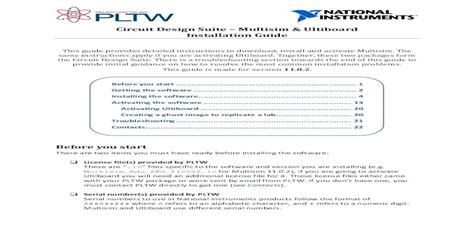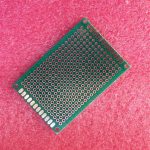Introduction to Ultiboard
Ultiboard is a powerful PCB design software that offers a comprehensive set of tools for creating high-quality printed circuit boards. Whether you’re a beginner or an experienced designer, Ultiboard provides an intuitive interface and a wide range of features to help you bring your electronic projects to life. In this ultimate guide, we’ll explore the key aspects of Ultiboard and provide you with the knowledge and resources you need to get started with this exceptional PCB design tool.
What is Ultiboard?
Ultiboard is a PCB design software developed by National Instruments. It is part of the NI Circuit Design Suite and is closely integrated with other NI tools such as Multisim, a circuit simulation software. Ultiboard offers a user-friendly environment for designing and laying out printed circuit boards, making it an excellent choice for beginners and professionals alike.
Key Features of Ultiboard
- Intuitive user interface
- Powerful routing and placement tools
- 3D visualization and rendering
- Design rule checking (DRC)
- Integration with Multisim for seamless schematic capture and simulation
- Extensive component libraries
- Support for multi-layer PCB designs
- Gerber and Drill File Generation for manufacturing
Getting Started with Ultiboard
System Requirements
Before installing Ultiboard, ensure that your computer meets the following minimum system requirements:
| Operating System | Processor | RAM | Disk Space |
|---|---|---|---|
| Windows 10 (64-bit) | Intel Core i5 or equivalent | 8 GB | 10 GB |
| macOS High Sierra (10.13) or later | Intel Core i5 or equivalent | 8 GB | 10 GB |
Installation Process
To install Ultiboard, follow these steps:
1. Download the NI Circuit Design Suite installer from the National Instruments website.
2. Run the installer and follow the on-screen instructions.
3. Select the components you wish to install, including Ultiboard.
4. Choose the installation directory and click “Next”.
5. Wait for the installation to complete and launch Ultiboard.
Ultiboard User Interface Overview
Upon launching Ultiboard, you’ll be greeted with a user-friendly interface that consists of several key areas:
Workspace
The main area where you’ll design and lay out your PCB. You can switch between different views, such as 2D and 3D, to visualize your design from various perspectives.
Toolbars
Ultiboard provides a set of toolbars that grant quick access to commonly used tools and functions. These include the Standard toolbar, the Draw toolbar, and the Place toolbar, among others.
Panels
Various panels, such as the Project panel and the Properties panel, provide additional information and settings related to your PCB design. You can customize the panel layout to suit your preferences.
Menus
The menu bar at the top of the Ultiboard window contains a comprehensive set of commands and options for managing your projects, adjusting settings, and accessing advanced features.

PCB Design Workflow in Ultiboard
Creating a New Project
To start a new PCB design project in Ultiboard, follow these steps:
1. Click on “File” in the menu bar and select “New Project”.
2. Choose the project type (e.g., PCB Project) and click “OK”.
3. Enter a name for your project and select the project directory.
4. Click “Create” to create the new project.
Schematic Capture and Import
If you have an existing schematic created in Multisim or another schematic capture tool, you can easily import it into Ultiboard. To do so:
1. Click on “File” in the menu bar and select “Import”.
2. Choose the file format of your schematic (e.g., Multisim Schematic).
3. Browse to the location of your schematic file and click “Open”.
4. The schematic will be imported into Ultiboard, and you can proceed with the PCB layout process.
Component Placement
Once you have your schematic imported or created directly in Ultiboard, you can begin placing components on the PCB. Ultiboard offers several tools and features to streamline the component placement process:
Part Browser
The Part Browser allows you to search for and select components from Ultiboard’s extensive libraries. You can filter components by type, package, or other criteria to quickly find the parts you need.
Placement Grid
Ultiboard provides a customizable placement grid that helps you align components accurately on the PCB. You can adjust the grid size and snap settings to suit your design requirements.
Automatic Placement
For larger designs, Ultiboard offers an automatic placement feature that can save time and effort. The software uses advanced algorithms to optimize component placement based on factors such as connectivity and design rules.
Routing and Trace Management
Routing is the process of connecting components on the PCB using copper traces. Ultiboard provides a range of routing tools and features to help you create efficient and reliable connections:
Manual Routing
For precise control over trace placement, you can use Ultiboard’s manual routing tools. These tools allow you to draw traces directly on the PCB, adjust trace widths, and create custom shapes.
Automatic Routing
Ultiboard’s automatic routing feature can significantly speed up the routing process, especially for complex designs. The software uses advanced algorithms to calculate the optimal trace paths based on design rules and constraints.
Design Rule Checking (DRC)
Ultiboard includes a powerful Design Rule Checking (DRC) feature that helps you identify and resolve potential issues in your PCB layout. DRC checks your design against a set of predefined rules, such as minimum trace widths, clearances, and hole sizes, and reports any violations.
3D Visualization and Rendering
Ultiboard’s 3D visualization and rendering capabilities allow you to view your PCB design from various angles and perspectives. This feature is particularly useful for assessing component placement, clearances, and overall board aesthetics. You can generate realistic 3D renderings of your PCB, complete with component models and surface finishes.
Generating Manufacturing Files
Once your PCB design is complete, you’ll need to generate the necessary files for manufacturing. Ultiboard supports the generation of industry-standard Gerber and drill files, which are used by PCB Fabrication houses to produce your boards. To generate manufacturing files:
1. Click on “File” in the menu bar and select “Fabrication Outputs”.
2. Choose the desired output format (e.g., Gerber RS-274X) and select the layers to include.
3. Specify the output directory and click “OK” to generate the files.
Tips and Best Practices for PCB Design in Ultiboard
Keep Your Schematic Organized
A well-organized schematic is essential for a successful PCB design. Use clear and consistent naming conventions for components and nets, and group related components together for easier navigation.
Use a Consistent Grid Size
Establish a consistent grid size for your PCB layout to ensure proper alignment and spacing of components. A grid size of 25 or 50 mils is common for most designs.
Follow Design Rules and Guidelines
Adhere to the design rules and guidelines provided by your PCB Manufacturer to ensure that your board can be successfully fabricated. This includes minimum trace widths, clearances, and drill sizes.
Optimize Component Placement
Place components strategically to minimize trace lengths and reduce signal interference. Consider factors such as heat dissipation, mechanical stress, and user interaction when placing components.
Use Ground Planes
Incorporate ground planes in your PCB design to improve signal integrity, reduce noise, and provide a stable reference for your circuits. Ultiboard allows you to easily define and manage ground planes in your design.
Regularly Check for Design Rule Violations
Use Ultiboard’s Design Rule Checking (DRC) feature frequently throughout the design process to identify and resolve any potential issues early on. This will save you time and effort in the long run.
Frequently Asked Questions (FAQ)
-
Q: Is Ultiboard suitable for beginners with no prior PCB design experience?
A: Yes, Ultiboard is an excellent choice for beginners. Its intuitive user interface and comprehensive set of tools make it easy to get started with PCB design, even if you have no prior experience. -
Q: Can I import schematic designs from other software into Ultiboard?
A: Yes, Ultiboard supports the import of schematic designs from various software, including Multisim. You can easily bring your existing schematics into Ultiboard and proceed with the PCB layout process. -
Q: Does Ultiboard offer automatic routing capabilities?
A: Yes, Ultiboard provides an automatic routing feature that can significantly speed up the routing process, especially for complex designs. The software uses advanced algorithms to calculate the optimal trace paths based on design rules and constraints. -
Q: Can I generate 3D renderings of my PCB design in Ultiboard?
A: Yes, Ultiboard offers powerful 3D visualization and rendering capabilities. You can view your PCB design from various angles and generate realistic 3D renderings, complete with component models and surface finishes. -
Q: What types of manufacturing files can I generate from Ultiboard?
A: Ultiboard supports the generation of industry-standard Gerber and drill files, which are used by PCB fabrication houses to produce your boards. You can easily generate these files from within the software, ensuring that your design is ready for manufacturing.
Conclusion
Ultiboard is a powerful and user-friendly PCB design software that offers a comprehensive set of tools for creating high-quality printed circuit boards. Whether you’re a beginner or an experienced designer, Ultiboard provides an intuitive interface and a wide range of features to help you bring your electronic projects to life.
By following the tips and best practices outlined in this guide, you’ll be well on your way to designing professional-grade PCBs using Ultiboard. Remember to keep your schematic organized, follow design rules and guidelines, optimize component placement, and regularly check for design rule violations to ensure a successful PCB design process.
With Ultiboard’s extensive capabilities and seamless integration with other NI tools, such as Multisim, you have everything you need to transform your ideas into reality. So, grab your computer, fire up Ultiboard, and start designing the PCBs that will power your next groundbreaking electronic project!






Leave a Reply